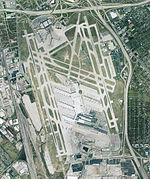Louisville Muhammad Ali International Airport (IATA: SDF, ICAO: KSDF, FAA LID: SDF), formerly known as simply Louisville International Airport, is a civil-military airport in Louisville in Jefferson County, Kentucky. The airport covers 1,500 acres (6.1 km2) and has three runways. Its IATA airport code, SDF, is based on the airport's former name, Standiford Field. Despite being called an international airport, it has no regularly-scheduled international passenger flights, but is a port of entry, handling many UPS Airlines international cargo flights through the United Parcel Service's worldwide air hub, often referred to as UPS Worldport.Over 4.2 million passengers and over 5.7 billion pounds (2.89 million tons) of cargo passed through the airport in 2019. It is also the second-busiest in the United States in terms of cargo traffic, and fourth-busiest for such in the world. The National Plan of Integrated Airport Systems for 2011–2015 categorized it as a "primary commercial service" airport since it has over 10,000 passenger boardings (enplanements) per year. Federal Aviation Administration records show the airport had 1,877,861 revenue enplanements in 2018, an increase of 11.46% from 1,684,738 in 2017.Because of UPS Airlines' operations, Louisville International Airport is the second-busiest cargo airport in the United States, only falling short of FedEx's SuperHub at Memphis International Airport, and also the world's fourth-busiest airport by cargo traffic, behind Shanghai Pudong, Memphis and Hong Kong. The Kentucky Air National Guard's 123d Airlift Wing operates C-130 transport aircraft from the co-located Louisville Air National Guard Base.
On January 16, 2019, the Regional Airport Authority voted to change the name of the airport to Louisville Muhammad Ali International Airport in honor of the boxer and Louisville native Muhammad Ali. On June 6, 2019, the airport unveiled its new logo, featuring "Ali's silhouette, arms up and victorious, against the background of a butterfly."




